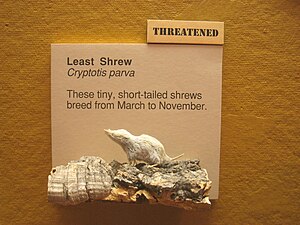Field Guide/Mammals/Least Shrew
< Field Guide | Mammals
| Cryptotis parva (Least Shrew) | |
|---|---|
|
Family: Soricidae
Size: Total Length – 2.7 to 3.4 inches (68 to 86 mm); Tail Length – 0.5 to 0.7 inches (13 to 18 mm); Weight – 0.1 to 0.2 oz (4 to 6.5 grams) [1]
Description: Least shrews have dense, short hair; which is dark brown to reddish brown on the dorsal side during the winter. Fur becomes grayish brown in color during the summer. They have a bi-colored tail, with a darker brown on top and a lighter underside.[1]
Similar Species: Smallest of the shrews, they can be distinguished by their tail length.
Range: The least shrew is widely distributed across the eastern United States, and southward into Central America. However, it is only known in Minnesota from a single male specimen collected in Winona County.[2]
Habitat: Least shrews are commonly found in open fields with tall grasses or areas with fallen trees and brush that provide protection.[1]
Diet: Least shrews eat insects, earthworms, snails, and carrion. When those types of food are scarce they may eat seeds and fruit. Emergency supplies of food are stored.[3]
Activity: Least Shrews are social animals and often share burrows. They make nests out of leaves or dig burrows, which they line with leaves and grass. They also will use old burrows and runways of other mammals, such as voles.[4]
Reproduction: Least shrews may reproduce several times during the mating season, which lasts from February to November. Gestation lasts 21 to 23 days. Females give birth to an average of 5 young per litter, though litters can range from 2 to 7 individuals.[1]
Lifespan: Least shrews tend to live a little over a year in the wild. Captive least shrews can live for roughly 21 months.[1]
Notes: Carnivorious mammals capture and kill these shrews, but rarely eat them because of the specialized skin glands that are distasteful to these carnivores. The principal gland is the flank gland, which is better developed in males than females after sexual maturity.[3]
|
 |
- ↑ a b c d e ADW: Cryptotis parva: INFORMATION, retrieved September 21, 2012
- ↑ Species profile: Minnesota DNR, retrieved September 21, 2012
- ↑ a b Shrews (Family Soricidae), retrieved September 21, 2012
- ↑ Least Shrew, retrieved September 21, 2012